Barrenwort Epimedium leptorrhizum

ABOUT
Epimedium leptorrhizum, also known as barrenwort, is a herbaceous perennial known for its decorative and distinctive appearance. This plant often features heart-shaped or spade-like leaves that are a luscious green, sometimes with a hint of bronze, especially when new. As the seasons change, the foliage may turn to a reddish-brown, adding a burst of color to garden spaces. Barrenwort is also renowned for its delicate, nodding flowers which seem to float above the foliage on slender stems. The blossoms are typically small, with four outer petals that often have a lighter or contrasting color. The petals can give the flowers a fairy-wing like appearance, with spur-like extensions at the base. The flowers may range in color from pale pink to lavender or deep purple, often with a splash of yellow at the center, offering a captivating display in the springtime. This enchanting plant has a robust and clump-forming habit, creating an almost carpet-like ground cover in the right conditions. Its visual charm and subtle beauty make barrenwort a favorite among garden enthusiasts, providing a touch of whimsy and natural elegance to shaded garden areas.
About this plant
 Names
NamesSynonyms
Longspur Epimedium, Longspur Fairy Wings.
Common names
Epimedium leptorrhizum.
 Toxicity
ToxicityTo humans
Epimedium leptorrhizum, commonly known as barrenwort, is not widely documented as a toxic plant to humans. There is limited information available on its toxicity and potential consequences of ingestion. However, as with any plant, individual allergies or sensitivities may exist, and it is generally advisable to avoid ingesting parts of plants that are not commonly recognized as food sources. If you suspect poisoning from any plant, contact a medical professional for advice.
To pets
Barrenwort, the common name for Epimedium leptorrhizum, is not known to be a toxic plant to pets such as dogs and cats. There is no widely recognized information indicating that ingestion of barrenwort by pets leads to poisoning. However, pets may have individual sensitivities or allergies, and it is generally wise to prevent pets from consuming non-food plants. If you observe any unusual symptoms in your pet after it has ingested this plant, please consult your veterinarian.
 Characteristics
CharacteristicsLife cycle
Perennials
Foliage type
Deciduous
Color of leaves
Green
Flower color
Yellow
Height
1 foot [30 cm]
Spread
1 foot [30 cm]
Plant type
Herb
Hardiness zones
5
Native area
China
Benefits
 General Benefits
General Benefits- Ground Cover - Epimedium leptorrhizum, commonly known as barrenwort, can serve as an attractive ground cover, filling in spaces in gardens and providing greenery throughout the year.
- Drought Tolerance - Once established, barrenwort is generally drought-tolerant, requiring minimal supplemental water in dry conditions.
- Shade Tolerance - Barrenwort thrives in partial to full shade, making it an ideal choice for woodland gardens or shaded areas where many other plants struggle.
- Erosion Control - The spreading habit and dense growth of barrenwort help stabilize soil and prevent erosion in sloped or uneven garden areas.
- Low Maintenance - Barrenwort is known for needing very little care once it has settled into its growing environment, making it convenient for the low-maintenance gardener.
- Seasonal Interest - With its delicate blooms in the spring and attractive foliage that can change color in the fall, barrenwort provides visual interest throughout multiple seasons.
- Resilience to Pests and Disease - Barrenwort is generally resistant to pests and diseases, reducing the need for chemical treatments in the garden.
- Wildlife Attraction - While barrenwort does not emphasize wildlife attraction, its flowers can sometimes entice pollinators such as bees to the garden.
- Deer and Rabbit Resistance - Barrenwort is not favored by deer or rabbits, making it a good choice in areas where these animals may browse on garden plants.
 Medical Properties
Medical Properties- Libido Enhancement: Epimedium, commonly known as "Horny goat weed," has been traditionally used to improve sexual function and boost libido.
- Osteoporosis Treatment: Epimedium contains icariin, which has been studied for its potential effects on bone density and might be used in treating conditions like osteoporosis.
- Anti-Inflammatory Effects: Some compounds in Epimedium may have anti-inflammatory properties, which could be useful in reducing inflammation in the body.
- Cardiovascular Health: There is some evidence suggesting that Epimedium could improve cardiovascular health by increasing blood flow and lowering blood pressure.
- Neuroprotective Properties: Icariin and other flavonoids present in Epimedium might possess neuroprotective effects, potentially beneficial for neurodegenerative diseases.
- Immunomodulatory Effects: Certain compounds in Epimedium may help in modulating the immune system, although more research is needed to understand this effect fully.
- Antioxidant Activity: The plant has antioxidant properties, which help in combating oxidative stress and may contribute to overall health.
 Air-purifying Qualities
Air-purifying QualitiesThis plant is not specifically known for air purifying qualities.
 Other Uses
Other Uses- Epimedium leptorrhizum, commonly known as "Bishop's Hat," can be used as a groundcover in shady areas due to its spreading nature and tolerance of low light conditions.
- The plant's colorful leaves can provide a decorative element when dried and used in floral arrangements or crafts.
- In the garden, Bishop's Hat can be employed as an edging species along walkways or garden borders, bringing texture and color contrast.
- The young leaves of Bishop's Hat may be used for edible garnishes, provided they're free of any pesticides and contaminants.
- Erosion control on slopes or banks is another application, as the plant's roots help stabilize the soil and prevent runoff.
- Bishop's Hat can be used to create a naturalistic setting in a woodland garden, providing a backdrop for other woodland species.
- The foliage can act as a cover for small garden fauna, offering shelter for insects and possibly small garden reptiles or amphibians.
- Some gardening enthusiasts use the dried seed pods of Bishop's Hat in potpourri mixtures for their interesting shape and texture.
- During the autumn, the colorful leaves can add aesthetic value to a compost pile, eventually turning into a nutrient-rich soil amendment for the garden.
- Photographers and artists may use Bishop's Hat as a subject or backdrop for their work due to its intricate leaf patterns and delicate flowers.
Interesting Facts
 Feng Shui
Feng ShuiEpimedium, also known as Horny Goat Weed, is not traditionally used in Feng Shui practice.
 Zodiac Sign Compitability
Zodiac Sign CompitabilityEpimedium, also known as Horny Goat Weed, is not used in astrology practice.
 Plant Symbolism
Plant Symbolism- Love and Attraction: Epimedium leptorrhizum, commonly known as "Bishop's hat," often symbolizes love and attraction due to its aphrodisiac properties which have been recognized in traditional medicine.
- Longevity: The plant is believed to support vitality and longevity, making it a symbol of a long and healthy life.
- Tolerance: With its ability to thrive in challenging growing conditions, Bishop's hat can represent tolerance and endurance.
- Protective Charm: In some cultures, Epimedium spp. are thought to have protective qualities, warding off negative influences and bringing good luck.
 Water
WaterThe Barrenwort, commonly known as Epimedium leptorrhizum, should be watered deeply once a week, with about 1-1.5 gallons of water, ensuring moisture penetration to the root zone. During periods of drought or extreme heat, increase watering frequency to twice a week. Adjust watering based on rainfall, lessening the amount when natural precipitation provides sufficient moisture. Always allow the top inch of the soil to dry out before watering again to prevent root rot, and be mindful that container-grown plants may need more frequent watering than those in the ground.
 Light
LightBarrenwort thrives in light conditions that include partial shade to full shade. A spot under deciduous trees that provide dappled sunlight is ideal, as the plant is protected from the harsh midday sun. Avoid placing it in full sun, which can scorch the leaves and stress the plant.
 Temperature
TemperatureBarrenwort prefers a temperature range between 50°F and 75°F for optimal growth. It can survive minimum temperatures down to -30°F, making it suitable for many temperate climates. However, its evergreen foliage may suffer in areas that experience harsh winters with extreme cold.
 Pruning
PruningPruning Barrenwort should be done in late winter or early spring, to remove old, damaged, or dead foliage and to maintain plant vigor. This timing allows the plant to be freshened up before new growth starts. Pruning annually will also help in enhancing the blooming in the following season.
 Cleaning
CleaningAs needed
 Soil
SoilBishop's hat prefers a well-drained soil rich in organic matter with a pH of 5.5 to 7.5. A mix of loamy soil, peat moss, and perlite or pine bark would provide the ideal structure and nutrition. Ensure the soil is moist but not waterlogged to support its growth.
 Repotting
RepottingBishop's hat does not need frequent repotting and can thrive in the same pot for several years. Repot the plant every 2-3 years to refresh the soil and provide room for growth, typically in the spring.
 Humidity & Misting
Humidity & MistingBishop's hat flourishes in moderate humidity levels, typically around 30% to 50%. Avoid locations with very dry air but also be cautious of excessive humidity which may lead to fungal issues.
 Suitable locations
Suitable locationsIndoor
Place in bright, indirect light with moist soil.
Outdoor
Part shade, moist soil, shelter from harsh sun.
Hardiness zone
5-9 USDA
 Life cycle
Life cycleEpimedium leptorrhizum, commonly known as the longroot barrenwort, begins its life cycle when seeds germinate in moist, well-drained soil in partial to full shade. Seedlings emerge with characteristic heart-shaped leaves and establish a root system which includes a thickened rhizome. Over time, the plant forms dense clumps with multiple evergreen to semi-evergreen leaves that may turn reddish in the autumn. In spring, the longroot barrenwort produces small, intricate flowers suspended on wiry stems above the foliage, after which pollination can occur, leading to the development of dry capsule fruits containing seeds. The seeds require a cold period to break dormancy before the next germination cycle can begin. With each year, the plant expands its clump size by extending its rhizomes, contributing to the gradual spread within its growing area.
 Propogation
PropogationPropogation time
Spring to summer
Propogation: The most popular method of propagation for Epimedium leptorrhizum, commonly known as Barrenwort, involves dividing the plant. This is typically performed in late summer to early fall, just after the flowering period when the plant's growth starts to slow down. To propagate by division, the gardener should carefully lift the plant from the ground, ensuring as much of the root system as possible remains intact. The root clump can then be gently pulled apart into smaller sections, each containing several shoots and a healthy portion of roots. These divisions should be immediately replanted in well-prepared soil, ensuring they're spaced appropriately to allow for future growth. It's important to maintain adequate moisture levels after planting to encourage establishment.
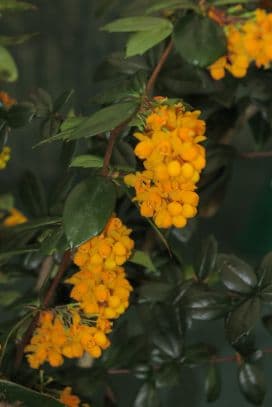
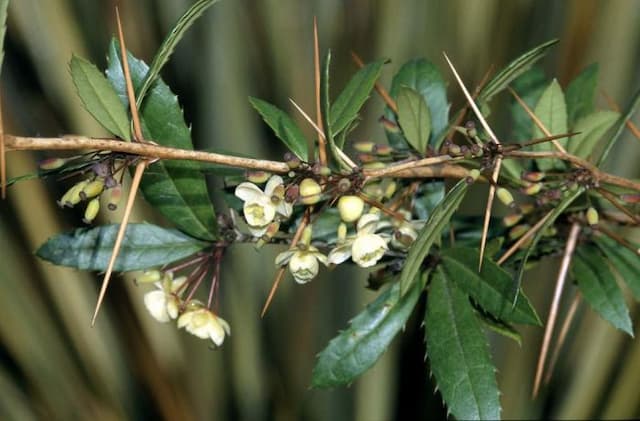
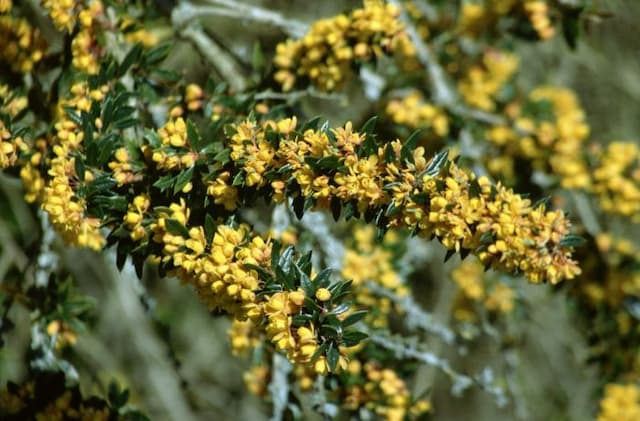
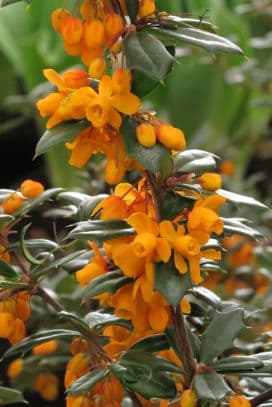
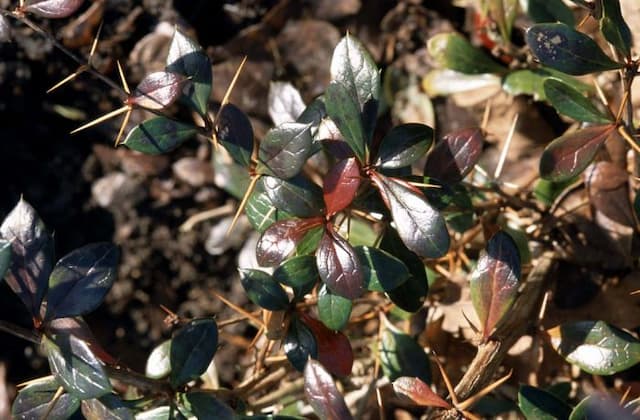



![Japanese barberry [Bonanza Gold]](/_next/image?url=https%3A%2F%2Fplants-admin.emdemapps.com%2Fimages%2Fplants%2F%2Fimages%2F604b5385e413f.png&w=640&q=75)
